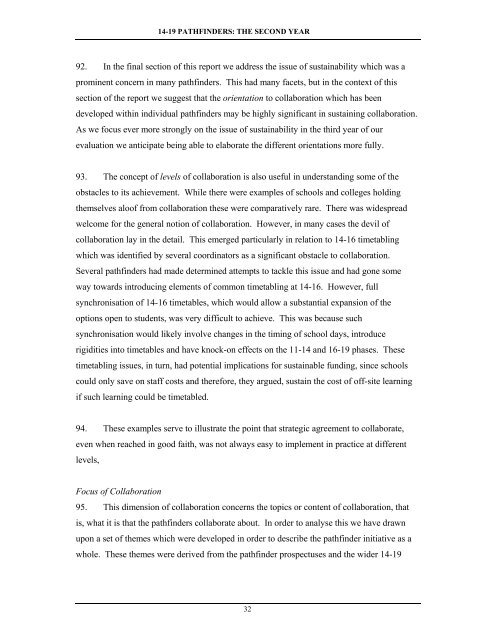Collaborative Approaches to 14-19 Provision - Communities and ...
Collaborative Approaches to 14-19 Provision - Communities and ...
Collaborative Approaches to 14-19 Provision - Communities and ...
- No tags were found...
You also want an ePaper? Increase the reach of your titles
YUMPU automatically turns print PDFs into web optimized ePapers that Google loves.
<strong>14</strong>-<strong>19</strong> PATHFINDERS: THE SECOND YEAR92. In the final section of this report we address the issue of sustainability which was aprominent concern in many pathfinders. This had many facets, but in the context of thissection of the report we suggest that the orientation <strong>to</strong> collaboration which has beendeveloped within individual pathfinders may be highly significant in sustaining collaboration.As we focus ever more strongly on the issue of sustainability in the third year of ourevaluation we anticipate being able <strong>to</strong> elaborate the different orientations more fully.93. The concept of levels of collaboration is also useful in underst<strong>and</strong>ing some of theobstacles <strong>to</strong> its achievement. While there were examples of schools <strong>and</strong> colleges holdingthemselves aloof from collaboration these were comparatively rare. There was widespreadwelcome for the general notion of collaboration. However, in many cases the devil ofcollaboration lay in the detail. This emerged particularly in relation <strong>to</strong> <strong>14</strong>-16 timetablingwhich was identified by several coordina<strong>to</strong>rs as a significant obstacle <strong>to</strong> collaboration.Several pathfinders had made determined attempts <strong>to</strong> tackle this issue <strong>and</strong> had gone someway <strong>to</strong>wards introducing elements of common timetabling at <strong>14</strong>-16. However, fullsynchronisation of <strong>14</strong>-16 timetables, which would allow a substantial expansion of theoptions open <strong>to</strong> students, was very difficult <strong>to</strong> achieve. This was because suchsynchronisation would likely involve changes in the timing of school days, introducerigidities in<strong>to</strong> timetables <strong>and</strong> have knock-on effects on the 11-<strong>14</strong> <strong>and</strong> 16-<strong>19</strong> phases. Thesetimetabling issues, in turn, had potential implications for sustainable funding, since schoolscould only save on staff costs <strong>and</strong> therefore, they argued, sustain the cost of off-site learningif such learning could be timetabled.94. These examples serve <strong>to</strong> illustrate the point that strategic agreement <strong>to</strong> collaborate,even when reached in good faith, was not always easy <strong>to</strong> implement in practice at differentlevels,Focus of Collaboration95. This dimension of collaboration concerns the <strong>to</strong>pics or content of collaboration, thatis, what it is that the pathfinders collaborate about. In order <strong>to</strong> analyse this we have drawnupon a set of themes which were developed in order <strong>to</strong> describe the pathfinder initiative as awhole. These themes were derived from the pathfinder prospectuses <strong>and</strong> the wider <strong>14</strong>-<strong>19</strong>32
















